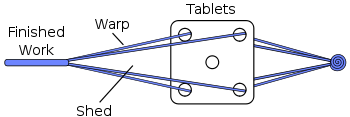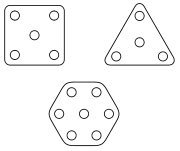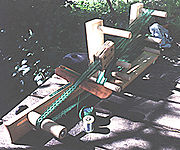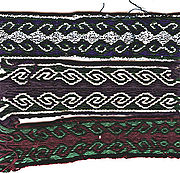
Tablet weaving
Encyclopedia

Weaving
Weaving is a method of fabric production in which two distinct sets of yarns or threads are interlaced at right angles to form a fabric or cloth. The other methods are knitting, lace making and felting. The longitudinal threads are called the warp and the lateral threads are the weft or filling...
technique where tablets or cards are used to create the shed
Shed (weaving)
In weaving, the shed is the temporary separation between upper and lower warp yarns through which the weft is woven. The shed is created to make it easy to interlace the weft into the warp and thus create woven fabric. Most types of looms have some sort of device which separates some of the warp...
through which the weft
Weft
In weaving, weft or woof is the yarn which is drawn through the warp yarns to create cloth. In North America, it is sometimes referred to as the "fill" or the "filling yarn"....
is passed. The technique is limited to narrow work such as belts, straps, or garment trim.
The origins of this technique go back at least to the early Iron age
Iron Age
The Iron Age is the archaeological period generally occurring after the Bronze Age, marked by the prevalent use of iron. The early period of the age is characterized by the widespread use of iron or steel. The adoption of such material coincided with other changes in society, including differing...
. Examples have been found at Hochdorf
Hochdorf
Hochdorf may refer to* Hochdorf, Lucerne, a municipality in Switzerland* Hochdorf , a district in the Canton of Lucerne, Switzerland* Hochdorf, Esslingen, a municipality in the district of Esslingen, Baden-Württemberg, Germany...
, Germany
Germany
Germany , officially the Federal Republic of Germany , is a federal parliamentary republic in Europe. The country consists of 16 states while the capital and largest city is Berlin. Germany covers an area of 357,021 km2 and has a largely temperate seasonal climate...
, and Apremont
Apremont
-France:* Apremont, Ain, in the Ain département* Apremont, Ardennes, in the Ardennes département* Apremont, Oise, in the Oise département* Apremont, Haute-Saône, in the Haute-Saône département* Apremont, Savoie, in the Savoie département...
, France. Tablet-woven bands are commonly found in Iron age graves and are presumed to be standard trim for garments among various peoples, including the Vikings.
As the materials and tools are relatively cheap and easy to obtain, tablet weaving is popular with hobbyist weavers.
Tools

Regular polygon
A regular polygon is a polygon that is equiangular and equilateral . Regular polygons may be convex or star.-General properties:...
s, with holes near each vertex and possibly at the center, as well. The number of holes in the tablets used is a limiting factor on the complexity of the pattern woven. The corners of the tablets are typically rounded to prevent catching as they are rotated during weaving.
In the past, weavers made tablets from bark
Bark
Bark is the outermost layers of stems and roots of woody plants. Plants with bark include trees, woody vines and shrubs. Bark refers to all the tissues outside of the vascular cambium and is a nontechnical term. It overlays the wood and consists of the inner bark and the outer bark. The inner...
, wood
Wood
Wood is a hard, fibrous tissue found in many trees. It has been used for hundreds of thousands of years for both fuel and as a construction material. It is an organic material, a natural composite of cellulose fibers embedded in a matrix of lignin which resists compression...
, bone
Bone
Bones are rigid organs that constitute part of the endoskeleton of vertebrates. They support, and protect the various organs of the body, produce red and white blood cells and store minerals. Bone tissue is a type of dense connective tissue...
, horn
Horn (anatomy)
A horn is a pointed projection of the skin on the head of various animals, consisting of a covering of horn surrounding a core of living bone. True horns are found mainly among the ruminant artiodactyls, in the families Antilocapridae and Bovidae...
, stone
Rock (geology)
In geology, rock or stone is a naturally occurring solid aggregate of minerals and/or mineraloids.The Earth's outer solid layer, the lithosphere, is made of rock. In general rocks are of three types, namely, igneous, sedimentary, and metamorphic...
, leather
Leather
Leather is a durable and flexible material created via the tanning of putrescible animal rawhide and skin, primarily cattlehide. It can be produced through different manufacturing processes, ranging from cottage industry to heavy industry.-Forms:...
, metal
Metal
A metal , is an element, compound, or alloy that is a good conductor of both electricity and heat. Metals are usually malleable and shiny, that is they reflect most of incident light...
or a variety of other materials. Modern cards are frequently made from cardboard
Paperboard
Paperboard is a thick paper based material. While there is no rigid differentiation between paper and paperboard, paperboard is generally thicker than paper. According to ISO standards, paperboard is a paper with a basis weight above 224 g/m2, but there are exceptions. Paperboard can be single...
. Some weavers even drill holes in a set of playing card
Playing card
A playing card is a piece of specially prepared heavy paper, thin cardboard, plastic-coated paper, cotton-paper blend, or thin plastic, marked with distinguishing motifs and used as one of a set for playing card games...
s. This is an easy way to get customized tablets or large numbers of inexpensive tablets.
The tablets are usually marked with colors or stripes so that their facings and orientations can be easily noticed.
Procedure

Traditionally, one end of the warp was tucked into, or wrapped around the weaver's belt, and the other is looped over a toe, or tied to a pole or furniture. Some traditional weavers weave between two poles, and wrap the weft around the poles. Commercial "tablet weaving looms" adapt this idea, and are convenient because they make it easy to put the work down.

A shuttle
Shuttle (weaving)
A shuttle is a tool designed to neatly and compactly store weft yarn while weaving. Shuttles are thrown or passed back and forth through the shed, between the yarn threads of the warp in order to weave in the weft....
about twice as wide as the ribbon is placed in the shed
Shed (weaving)
In weaving, the shed is the temporary separation between upper and lower warp yarns through which the weft is woven. The shed is created to make it easy to interlace the weft into the warp and thus create woven fabric. Most types of looms have some sort of device which separates some of the warp...
to beat the previous weft, then carry the next weft into the shed. Shuttles made for tablet weaving have sharp edges to beat down the weft. The best shuttles have plates to cover the bobbin, and keep it from catching the warp. Simple flat wooden or plastic shuttles work well for weaving with large yarns, but weaving with finer threads goes more quickly with a tablet-weaving shuttle.

Tablet weaving is especially freeing, because any pattern can be created by turning individual tablets. This is in contrast to normal looms, in which the complexity of the pattern is limited by the number of shafts available to lift threads, and the threading of the heddle
Heddle
A heddle is an integral part of a loom. Each thread in the warp passes through a heddle, which is used to separate the warp threads for the passage of the weft. The typical heddle is made of cord or wire, and is suspended on a shaft of a loom. Each heddle has an eye in the center where the warp is...
s.
Tablet weaving can also be used to weave tubes or double weave. The tablets are made to have four levels in the warp, and then two sheds are beat and wefted, one in the top pair of warps, and the other in the bottom pair, before turning the deck. Since groups of tablets can be turned separately, the length, width and joining of the tubes can be controlled by the weaver.

